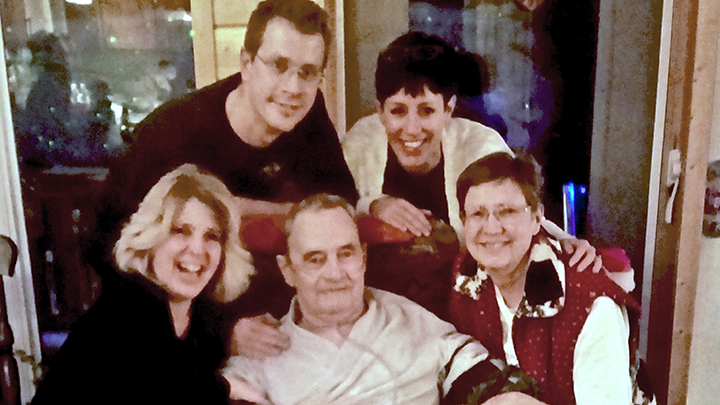
April 3, 2017

Roger LaPointe, centre, joined his family to celebrate Christmas Eve last year. With him, from left, were: daughter Jacqueline, son Steven, daughter Lisa Blacklock, and Roger’s wife Jeanette. LaPointe passed away from lung cancer two months later, but was able to spend that time at home, looked after by a team of healthcare professionals.
Story by: Melissa Ballantyne
When Roger LaPointe found he had metastatic lung cancer last July, he had had enough. He didn’t want chemo or radiation. He didn’t want to go into the hospital.
What he wanted was to die at home, in his own bed, surrounded by the people he loved most.
“Dad didn’t like needles or being in the hospital,” says LaPointe’s daughter, Lisa Blacklock. “He knew the cancer would likely end his life and he told us he didn’t want to spend his last days in the hospital.”
Thanks to the work of his Alberta Health Service (AHS) healthcare team and a complex co-ordination of care, services and communication, LaPointe’s wish to die at home was fulfilled.
“My dad was so grateful to be able to stay at home,” Blacklock says. “The overall quality of life the care team helped provide was so important. People can have good quality of life up to their last day.”
For LaPointe, the last day was Feb. 10. The 71-year-old Bergen Springs resident passed away in his own bed, surrounded by his wife Jeanette, daughters Lisa and Jacqueline, son Steven, and Steven’s wife Robyn.
“It was a peaceful day. Jackie had been reading to him from Chicken Soup for the Soul,” Blacklock recalls. “She was taking a break and then dad’s breathing changed and I knew what it meant. I called everyone in and we gathered around and were right by his side until the very end.”
LaPointe had lived with heart disease for more than 30 years, undergoing several open heart and bypass surgeries. Blacklock says he was tired of hospitals. With the lung cancer diagnosis, he wanted to die at home. What he didn’t know was how important a collaborative approach by health professionals would be in making it happen.
AHS palliative care resource nurse Deana McNeish worked with LaPointe, co-ordinating management of his pain and symptoms, end-of-life care planning, and pyscho-social support. His care team was multidisciplinary, involving home care, an occupational therapist, respiratory therapist, LaPointe’s family doctor and his head clinic nurse.
“Roger and his family really appreciated the work we put in to respect his wishes to remain at home,” says McNeish. “He enjoyed being involved in conversations about his care and being part of the decision-making. He always seemed happy to see us and enjoyed making us laugh.”
McNeish acknowledges providing end-of-life care at home can be challenge.
“In the communities I work in, family physicians are very busy,” McNeish says. “It can be a challenge to have open communication, make recommendations from my palliative care expertise, or for physicians to find time to meet on short notice to talk about the best ways to manage client care.”
She credits a proactive approach by Sundre physician Dr. Rob Warren who, along with his clinical nurse, would join McNeish on home visits when Lapointe was no longer able to leave the house.
Dr. Warren says working collaboratively is an important piece of putting the patient first, and involved a shift from historical roles that grew around the doctor being the centre of medical care.
“With our aging population, there’s a need for more individualized and patient-centred approaches. Sometimes that includes providing care where the patient is,” he says. “Every role within the healthcare system has significance. Working collaboratively and relying on the expertise of the people in those roles enables us to provide far better patient care than one of us could on our own.”
In additional to providing a higher level of care for patients, McNeish says the collaborative approach makes her job easier.
“I feel respected knowing that what I recommend as he best course of care for each particular patient is being listened to, reviewed, and acted on quickly.”
Patients and families feel respected, too. Blacklock credits her father’s care team with allowing him to die at home with dignity.
“My dad was always looking forward to the visits. He loved the nurses; they became like family,” she says. “They asked him questions and ensured he knew he was being heard. The language they used made him feel involved, like he had control and say about his care.”
That healthcare teamwork also made a difficult time much easier for LaPointe’s family.
“My entire family felt so supported through the process,” Blacklock says. “We felt good to be able to give dad the absolute best care possible at home, which is exactly what we wanted. This really helped all of us through his passing. Ultimately, we are comforted knowing we were able to give him what he asked for.”